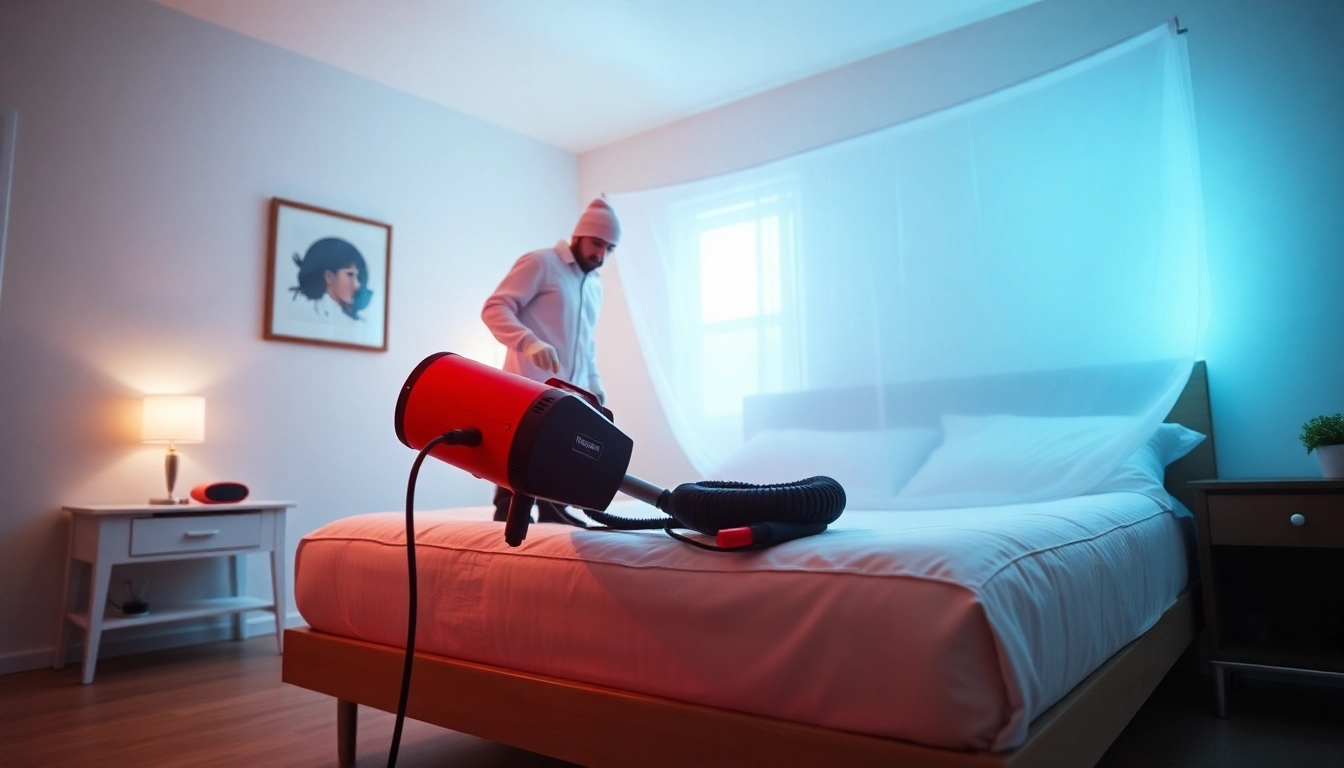Understanding Bed Bugs: Identification and Infestation Signs
What Are Bed Bugs?
Bed bugs are small, nocturnal insects belonging to the family Cimicidae. They are parasitic, feeding primarily on the blood of humans and other warm-blooded hosts. Adult bed bugs are approximately 1/4 inch in length, with a flat, oval shape, and can be easily identified by their reddish-brown coloration. These pests are notorious for their ability to reproduce rapidly—female bed bugs can lay hundreds of eggs in their lifetime, making infestations difficult to control.
How to Identify Bed Bug Bites
Identifying bed bug bites is an essential part of understanding whether you have an infestation. Bed bug bites typically appear as small, red, itchy welts. They often occur in a line or cluster, as bed bugs tend to bite multiple times in one area. The bites usually take a few days to manifest, making it challenging to connect them to the infestation’s source. It’s important to note that not everyone reacts to bed bug bites in the same way; some may experience severe allergic reactions, while others may not notice them at all.
Common Signs of Infestation in Your Home
Beyond bites, there are several other signs of bed bug infestations. Here are critical indicators to watch for:
- Physical Sightings: Look for adult bed bugs, nymphs, or eggs in common hiding spots such as mattress seams, box springs, and furniture joints.
- Fecal Spots: Small, dark spots on bedding or furniture can indicate bed bug droppings.
- Blood Stains: You might notice small blood stains on sheets or pillowcases, often resulting from crushed bugs during sleep.
- Sweet, Musty Odor: A strong musty smell can signal a significant infestation, as bed bugs emit pheromones that create this characteristic scent.
Proven Bed Bug Pest Control Methods
Heat Treatment for Bed Bug Removal
Heat treatment is one of the most effective ways to eliminate bed bugs. This method involves raising the temperature in an affected area to between 120°F to 145°F (49°C to 63°C) for several hours. Such high temperatures are lethal to bed bugs at all life stages:
- Efficiency: Heat effectively eradicates bed bugs and their eggs, reducing the likelihood of reinfestation.
- Non-Chemical Approach: As a non-toxic method, this is particularly beneficial for households concerned about chemical exposure.
However, heat treatment requires specialized equipment and professional expertise, making it essential to select a qualified bed bug pest control service.
Chemical Extermination Options Available
Chemical extermination remains a popular option for tackling bed bug infestations. There are various formulations available, including:
- Insecticides: These chemicals can be applied directly to surfaces, targeting adult bed bugs and nymphs.
- Residual Sprays: These formulations remain active on treated surfaces for an extended period, killing bed bugs that come into contact with them later.
- Foggers and Aerosols: These products can treat large areas but must be used cautiously to avoid toxicity.
While chemical options can be effective, they often require multiple treatments and should be paired with non-chemical methods for optimal results.
DIY Solutions: What Works and What Doesn’t
Many homeowners search for DIY solutions before resorting to professional pest control. While some methods can be effective, results often vary:
- Vacuuming: Regularly vacuuming infested areas can eliminate adult bed bugs and eggs. Ensure to dispose of the vacuum contents immediately.
- Steam Cleaning: Steamers can kill bed bugs on contact, making them an excellent choice for upholstery and carpets.
- Diatomaceous Earth: This natural insecticide can be sprinkled in areas of infestation. However, it works best in dry environments.
Keep in mind, complete eradication usually requires a professional approach, especially in severe cases.
Preventing Future Bed Bug Infestations
Best Practices for Bed Bug Prevention
Prevention is critical in managing bed bugs effectively. Here are several strategies to consider:
- Regular Inspections: Check for signs of bed bugs when traveling or bringing home used furniture.
- Sealing Cracks: Caulking gaps around skirting boards, windows, and electrical sockets can help minimize bed bug entry points.
- Clutter Reduction: Keeping living areas tidy limits the places where bed bugs can hide.
Using Mattress Encasements Effectively
Mattress encasements are a crucial tool in preventing bed bug infestations. By covering mattresses and box springs with a tight, protective layer, you can:
- Prevent Infestation: These covers act as a barrier that keeps bed bugs trapped inside and prevents new infestations from occurring.
- Monitor Infestations: Encased mattresses make detecting signs of bed bugs much easier during inspections.
Travel Tips to Avoid Bringing Home Bed Bugs
Travelers are often at risk of picking up bed bugs. Follow these tips to reduce the chances:
- Inspect Hotel Rooms: Before unpacking, check the bed, headboard, and furniture for signs of bed bugs.
- Luggage Management: Keep luggage off the floor and away from the bed to minimize exposure.
- Washing Clothes: Wash and dry clothing on high heat after traveling to kill any potential bed bugs.
Evaluating Bed Bug Pest Control Services
What to Look for in Exterminators
Choosing the right pest control professional can significantly impact the success of your treatment. Consider the following factors:
- Experience and Certifications: Look for exterminators who are certified and have specific experience handling bed bug treatments.
- Integrated Pest Management (IPM): A reputable company will employ an IPM approach, combining various methods for effective long-term results.
- Warranty and Follow-Up Treatments: Ensure they offer warranties and follow-up visits to monitor treatment efficacy.
Understanding Treatment Costs and Expectations
Bed bug treatment costs vary based on several factors:
- Size of Infestation: More extensive infestations typically require more resources and time, increasing costs.
- Location: Prices can differ significantly based on geographic region and local market conditions.
- Type of Treatment: Chemical, heat, or a combination of treatments each have different costs associated with them.
It’s essential to have a clear understanding of what your treatment will entail and the associated costs before proceeding.
Red Flags to Avoid When Hiring
Watch for potential warning signs when evaluating pest control companies:
- Lack of Credentials: Avoid companies that cannot provide proper licensing and certifications.
- Unrealistic Guarantees: Be wary of promises that claim complete eradication in one treatment with a money-back guarantee.
- Poor Customer Reviews: Check for feedback on platforms like Yelp or Google. A pattern of negative reviews can indicate a problem.
Real User Experiences and Success Stories
Case Studies: Successful Bed Bug Treatments
Real-life case studies can provide insights and reassurance when dealing with bed bug infestations. Here are a few examples:
- Case Study 1: A family in New York noticed signs of bed bugs after a vacation. They promptly hired an exterminator who conducted a thorough inspection and implemented a combination of heat and chemical treatments. The result was a completely bug-free home within a month.
- Case Study 2: A small apartment complex faced a challenging infestation. Management decided to engage an IPM approach, which included resident education and scheduled fumigation. This not only eliminated the problem but also established a prevention plan that significantly reduced the likelihood of future infestations.
Community Insights: Tips from Fellow Homeowners
Community forums and support groups can be a valuable resource. Homeowners often share their experiences and tips on dealing with bed bug infestations, including:
- Utilizing peer-reviewed methods from online resources for DIY treatments.
- Sharing personal experiences with various pest control companies to help others make informed decisions.
Frequently Asked Questions About Bed Bug Control
As bed bug concerns are widespread, many common questions arise:
- Can I treat bed bugs myself? While DIY methods may provide temporary relief, comprehensive treatment is often required to eliminate all bed bugs.
- How long does it take to get rid of bed bugs? Treatment duration can vary significantly based on the severity of the infestation and methods employed.
Engaging with a professional remains the most effective way to ensure a thorough approach to bed bug pest control.










Leave a Reply